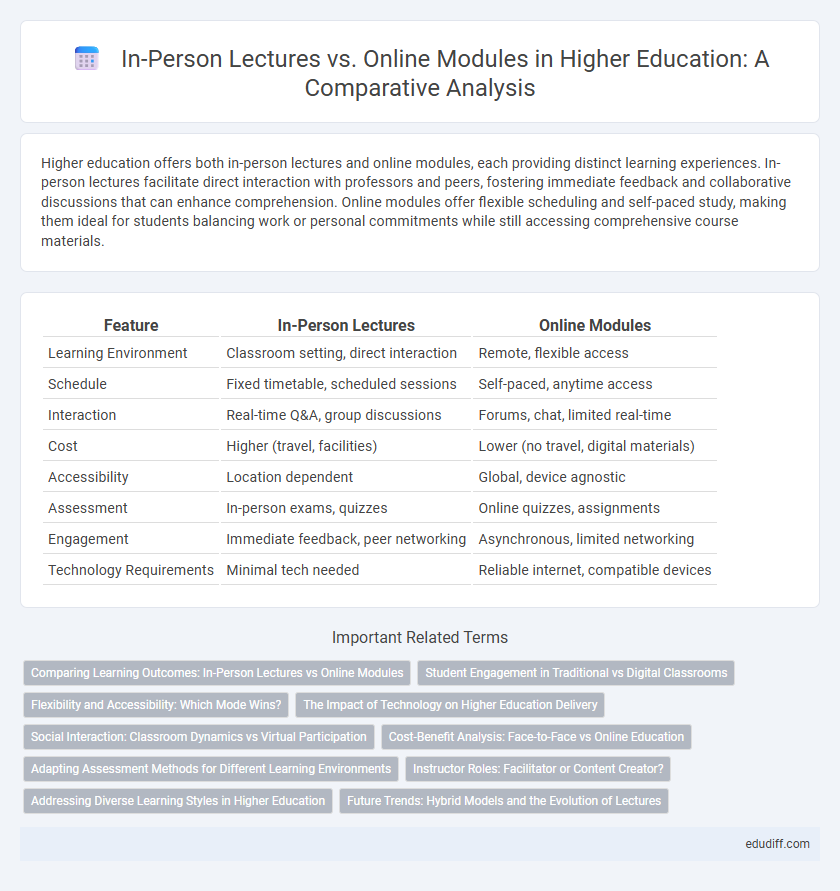Higher education offers both in-person lectures and online modules, each providing distinct learning experiences. In-person lectures facilitate direct interaction with professors and peers, fostering immediate feedback and collaborative discussions that can enhance comprehension. Online modules offer flexible scheduling and self-paced study, making them ideal for students balancing work or personal commitments while still accessing comprehensive course materials.
Table of Comparison
| Feature | In-Person Lectures | Online Modules |
|---|---|---|
| Learning Environment | Classroom setting, direct interaction | Remote, flexible access |
| Schedule | Fixed timetable, scheduled sessions | Self-paced, anytime access |
| Interaction | Real-time Q&A, group discussions | Forums, chat, limited real-time |
| Cost | Higher (travel, facilities) | Lower (no travel, digital materials) |
| Accessibility | Location dependent | Global, device agnostic |
| Assessment | In-person exams, quizzes | Online quizzes, assignments |
| Engagement | Immediate feedback, peer networking | Asynchronous, limited networking |
| Technology Requirements | Minimal tech needed | Reliable internet, compatible devices |
Comparing Learning Outcomes: In-Person Lectures vs Online Modules
In-person lectures facilitate real-time interaction, fostering immediate feedback and dynamic discussions which enhance comprehension and critical thinking skills. Online modules offer flexible pacing, enabling personalized learning paths that can improve retention and accessibility for diverse learning styles. Comparative studies indicate that blended approaches combining both methods often yield superior learning outcomes by leveraging the strengths of each format.
Student Engagement in Traditional vs Digital Classrooms
Student engagement in traditional classrooms often benefits from direct interpersonal interaction, dynamic group discussions, and immediate feedback, fostering deeper cognitive involvement. Online modules leverage multimedia content, interactive quizzes, and asynchronous communication to maintain engagement, yet may struggle with sustained attention due to distractions and lack of physical presence. Studies indicate that hybrid models combining in-person and digital elements can optimize engagement by harnessing the strengths of both instructional formats.
Flexibility and Accessibility: Which Mode Wins?
Online modules provide unparalleled flexibility by allowing students to access course materials anytime and anywhere, accommodating diverse schedules and learning paces. In-person lectures offer immediate interaction and structured environments but often require fixed attendance times and physical presence, limiting accessibility for remote or non-traditional students. The accessibility of online learning platforms, equipped with features like closed captions and mobile compatibility, significantly enhances inclusivity compared to conventional lecture halls.
The Impact of Technology on Higher Education Delivery
Technology has revolutionized higher education delivery by enabling flexible online modules that increase accessibility and accommodate diverse learning styles. In-person lectures continue to provide valuable face-to-face interaction and immediate feedback, enhancing student engagement and collaboration. Hybrid models combining digital tools with traditional instruction optimize educational outcomes by leveraging the strengths of both modalities.
Social Interaction: Classroom Dynamics vs Virtual Participation
In-person lectures foster dynamic classroom interactions that enhance student engagement through real-time discussions, spontaneous questions, and non-verbal cues, creating a rich social learning environment. Online modules often limit social interaction to scheduled video calls or discussion boards, reducing opportunities for immediate feedback and peer collaboration. The lack of physical presence in virtual participation can diminish the development of interpersonal skills and the sense of community essential for deeper academic motivation.
Cost-Benefit Analysis: Face-to-Face vs Online Education
Face-to-face education requires significant investment in physical infrastructure and commuting expenses, yet it offers rich interpersonal interactions that enhance learning outcomes. Online modules present cost savings by eliminating travel and facility costs while enabling flexible scheduling, but may suffer from reduced engagement and potential technology barriers. Evaluating both methods involves balancing tangible costs with the qualitative benefits of direct student-teacher interaction and accessibility.
Adapting Assessment Methods for Different Learning Environments
Adapting assessment methods for in-person lectures and online modules requires tailored approaches to accurately measure student learning outcomes. In-person assessments often utilize practical exams, oral presentations, and supervised quizzes to gauge immediate comprehension and engagement. Online modules benefit from diverse digital tools such as timed quizzes, interactive assignments, and asynchronous discussions that provide flexible yet rigorous evaluation aligned with remote learning dynamics.
Instructor Roles: Facilitator or Content Creator?
In-person lectures position instructors primarily as facilitators, guiding real-time discussions and adapting to student feedback dynamically. Online modules require instructors to act as content creators, developing comprehensive, engaging materials that anticipate diverse learner needs. This shift demands expertise in digital pedagogy and multimedia production to maximize instructional effectiveness.
Addressing Diverse Learning Styles in Higher Education
In-person lectures enhance kinesthetic and social learning by enabling real-time interaction and collaborative activities, while online modules provide flexible, multimedia-rich content catering to auditory and visual learners. Adaptive technologies embedded in online platforms allow personalized pacing and content customization, addressing the varied cognitive preferences across higher education students. Combining both modalities optimizes engagement and comprehension, supporting diverse learning styles effectively.
Future Trends: Hybrid Models and the Evolution of Lectures
Hybrid models combining in-person lectures with online modules are transforming higher education by enhancing flexibility and accessibility for diverse learner needs. Emerging technologies such as AI-driven analytics and interactive platforms enable real-time student engagement and personalized learning paths within these blended environments. Future trends indicate a continued shift towards adaptive hybrid classrooms that integrate immersive VR experiences and data-informed teaching strategies to optimize educational outcomes.
in-person lectures vs online modules Infographic

 edudiff.com
edudiff.com